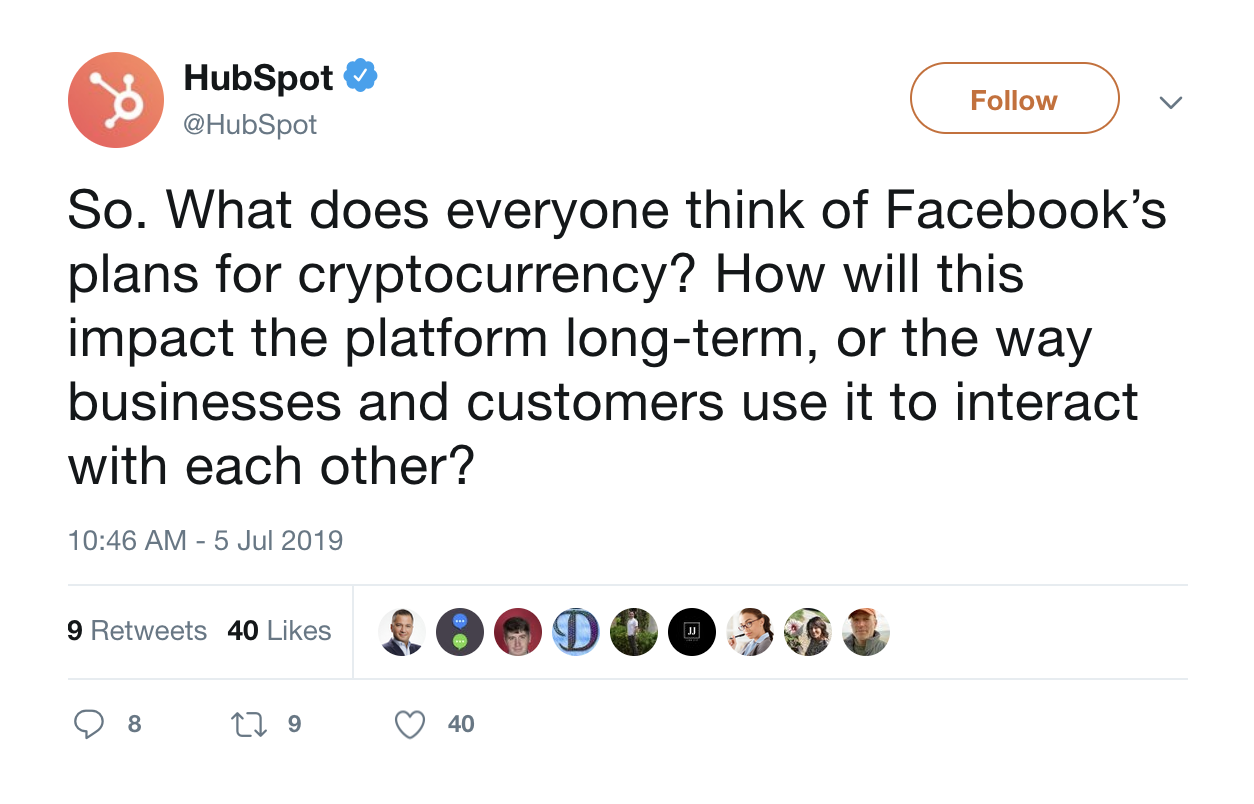B2B businesses are proof that any business can be successful on social media. Why? Because they've turned a niche industry that -- admittedly -- isn't the most exciting into a playground for social content.
When I think about B2B companies with a great social media presence, a lot of examples come to mind: IBM, Google, HubSpot, and so many more. These companies do an amazing job of sharing content that interests and builds their audience -- so much so that they don't seem too concerned with broadcasting their products or services constantly.
For a B2B company to be successful on social media, their content needs to find the middle ground between being engaging and not disrupting their audiences' experience on the platform. Ultimately, these companies need to figure out what their audience wants to see to truly reap the benefits of social media.
B2B companies have transformed the landscape of what it means to be a brand on social media. In order to engage and attract your own audience, then, consider the following strategies used in the B2B space that might lead your own social accounts to success.
10 B2B Social Media Strategies for Any Industry
1. Set SMART goals.
Like any other marketing channel, a social media strategy needs to be based off of goals in order to be successful. Defining specific, measurable KPIs for your company's social media -- whether they're based on brand awareness or acquisition -- will be the key to measuring success down the line.
To determine KPIs, you have to decide what success means to your brand. Are you trying to use social media as an acquisition channel? Do you want to increase your reach, or gain more traffic on your company blog? This will decide what metrics to track.
For instance, if your business is looking for leads, metrics like clicks and conversions are important. For brand awareness, it's more vital to consider engagement, reach, and impressions.
Here is an effective example of a SMART goal for a company that is just starting to gain traction on social media:
Goal: To build brand awareness on social media.
Specific: I want to boost our company's brand awareness by posting regularly and frequently on Twitter, Instagram, LinkedIn, and Facebook. I will increase our posts on Twitter from once to four times a day, post daily on Instagram, and increase weekly publishing frequency on LinkedIn and Facebook from four to seven times per week. Our content creators will increase their workload from creating two posts a week to three posts a week, and our designer will increase her workload from one asset a week to two assets a week.
Measureable: A 4% increase in engagement rate across the board is our goal.
Attainable: Our engagement rate increased by an average of 2% last month when we increased our weekly publishing frequency and spent more time on thoughtful, engaging copy.
Relevant: By increasing engagement rate, we'll boost brand awareness and generate more leads, giving sales more opportunities to close.
Time-Bound: End of this month.
SMART Goal: At the end of this month, our average engagement rate across our social media channels will see a 4% lift by increasing our post frequency and concentrating on thoughtful, engaging copy.
2. Keep an eye on competitors.
Social media opens the door to your competitor's marketing strategy, or at the very least, their social media marketing strategy. For larger companies, keeping tabs on your competitors is part of the territory. You want to know what campaigns they're running to see if they're successful. And if that company's target audience is similar to your own, you can take inspiration from that campaign.
But keeping tabs on your competitors on social media isn't at all about copying their strategies. Being involved in the same industry will lead to crossover with your audiences and their interests. If you see that your competitor isn't responding to trending news, then maybe it makes sense for your brand to do so. Looking for these opportunities will differentiate you from your competition.
3. Share original content.
This may seem like a no-brainer to some, but many businesses establish their social media presence on curating content from other sources. The truth is, your audience can tell the difference between content that is original and creative versus something you posted just to say you were active on the platform that day.
Social media shouldn't be just a distribution channel. Social media marketers also need to be content marketers to have a positive impact on their brand.
If you're having trouble coming up with original content everyday, it's okay to scale back your operation. If you don't have the bandwidth to post on every platform, spend your time on the channels where your audience is the most developed.
And if you need content creation inspiration, head to The Ultimate Guide to Content Creation.
4. Use multimedia.
There's a reason social media marketers get excited when a social platform launches a new feature -- it's because it adds a new medium to play with and test with your audience.
Instagram Stories, Twitter polls, and LinkedIn documents are all perfect examples of utilizing the multimedia formats that are unique to each channel.
Creating and publishing multimedia content on your social media channels adds an interest factor that will help you earn your audiences' attention.
Think of it this way -- if you scrolled through Twitter and only saw text-based posts, you'd get bored pretty quickly. The reason Twitter is addicting is because every Tweet is different. In a 10-second scroll you might come across a meme, a poll, a video, a photo collage, and a gif. The same should be true for your brand's feed.
When you think of social media content, you should be thinking about the story behind the post in addition to all the different ways you can tell it.
5. Highlight your employees.
Many B2B companies do a great job of spotlighting their employees, which allows the audience to put faces to the company and personalize the brand. This is important for small and large companies alike, because whether you're selling computers to businesses or opening a neighborhood restaurant -- people are the heart of your business.
Additionally, highlighting your employees is a good opportunity for employer branding. Employer branding increases your employees' advocacy by giving them the ability to spread word-of-mouth about their place of work.
Showcasing your staff may also increase your reach and engagement. For instance, instead of posting a product photo, you might post a photo of the 20 people who created the product, which would likely be shared with those 20 peoples' networks.
6. Have a distinguished brand voice.
Whenever your company posts a blog, edits a pillar page, or posts on social media, it gives you a chance to demonstrate your brand voice. Just like a customer would recognize your logo, you should strive for them to be able to recognize your brand voice, too.
Like any other marketing asset, your social content should always be aligned to your company's perspective. Does your company like to poke fun at challenges, or offer advice? Some of the most popular examples of consistent brand voice on social are fast-food companies like Burger King or Wendy's:
Wendy's approach makes a lasting impression on consumers because of how different it is from every other brand. But you don't have to make fun of a competitor in order to have a voice that stands out. Your brand voice can be friendly, casual, formal, snarky, humorous, serious, or any of the above.
If you're having a hard time identifying your brand voice, try looking back at past blog posts or landing page copy. Take note of the emotion and tone in the copy, and try to convey that in your social messaging.
Having a unique brand voice also gives you the opportunity to stand out in an already crowded marketplace.
If you want more tips for building your brand voice from the ground up, here is a helpful slideshow to get you started.
7. Offer support.
Nothing is more frustrating than tweeting at a brand with a customer support issue and hearing radio silence. Even if you don't have the bandwidth to create a separate Twitter account dedicated to support, keeping an eye out for these issues and replying to them right away is a good chance to rectify your customer relationship -- and shows future customers that you're there for them if a future problem arises.
8. Maintain consistency.
One of the hardest parts about posting on social media is maintaining consistency. Posting to every single channel every day takes a lot of time, content creation, and planning. If you're just starting out, try spending time creating smart content that adds to your audience's feeds instead of posting every day. It's better to push out a well thought out tweet that adds to the conversation and encourages engagement than five quick blog links with just an article title as the copy.
Another way to maintain consistency is to create a publishing calendar and schedule posts ahead of time using a social media tool.
9. Experiment with content and posting times.
This is a step to take after you've proven that you can maintain a regular posting schedule and want to dive a little deeper into audience insights. There are always best practices for when and what you're posting on social media, but the truth is that every audience is different, so you'll want to run experiments to figure out what works best for your brand.
There are endless experiments you can conduct on your channels. Here are some ideas to inspire you:
- Alternate between using questions and statistics in your copy to see which one pulls your audience in more.
- Test different link positions to find out if it makes users more likely to click.
- Add emojis to see if it increases interactions.
- Post more frequently.
- Post less frequently.
- Put paid behind a video post and a still image to see which performs better.
- Segment a different part of your audience to test how they react to an ad.
- Test different amounts of hashtags to see if it affects impressions.
- Spend more time replying to posts to find out if it increases your follower count.
Experimenting with your content is how you figure out your own best practices, which will always be more personalized than industry standards.
10. Engage in conversation
Social media was created to help people make connections with other people. Even though brands have entered and occupied the space for a while now, that sentiment hasn't changed.
Your brand won't be able to connect with your audience if all you're doing is pushing your product at them.
It's disruptive, and nobody wants to interact with a post that pulls them away from what they want their social feed to look like.
The key to staying relevant on social is to engage in the conversations your target audience is interested in having -- even if doesn't have much to do with your product. For instance, take a look at this tweet by HubSpot:

This tweet has nothing to do with HubSpot's product, but it does have to do with what HubSpot's audience is interested in. As a company, HubSpot knows that its users and potential customers are interested in tech news and what's happening in the business world. Therefore, it sparked conversation.
B2B companies aren't the only ones who can use these strategies for social media, and they've already proven that these strategies can work for a variety of target audiences -- so why not try employing some of these strategies on your own audience?
from Marketing https://ift.tt/2MkrxN4
via

No comments:
Post a Comment